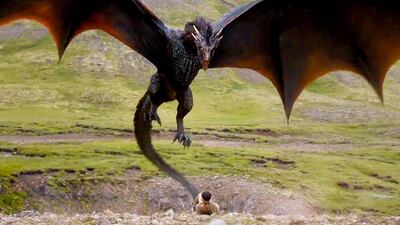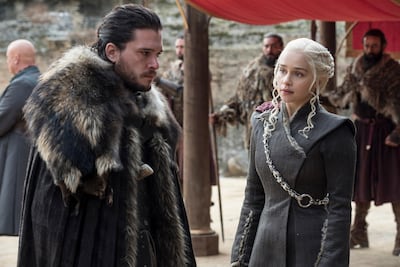At the very end of A Game of Thrones, the first book in George R R Martin's fantasy-historical series of blockbusters, is an appendix detailing the various dynasties of Westeros. In my gnarled edition, this separates the action proper from a preview of part two, A Clash of Kings, which begins: "George R R Martin is full of surprises!" Back then, we didn't know the half of it.
Normally in A Game of Thrones, an appendix is just another organ to be removed during battle or a Tyrion Lannister interrogation scene. Here, it presents rudimentary family trees of Westeros' major ruling Houses: Baratheon, Lannister and so on, ending with the House of Targaryen – "the old Dynasty" as a subtitle has it, and not as it sounds a luxury jeweller.
Martin’s potted history locates the Targaryens’ origins to Valyria, where they produced people of “striking (some say inhuman) beauty, with lilac or indigo or violet eyes and hair of silver-gold or platinum white.” These medieval New Romantics enjoyed intermarriage (presumably no one else was strikingly or inhumanly beautiful enough), a smart sense that their homeland was about to become uninhabitable (the “Doom of Valyria”) and their Targaryen pet: the Dragon. It was this fearsome beast that gave them a considerable leg-up when it came to what happened next.
Under the leadership of Aegon the Dragon, ably assisted by his sisters and future brides Visenya and Rhaenys, the Targaryens fled Valyria and sailed to the Seven Kingdoms of Westeros with an unmistakable colonising look in those lilac (or indigo or violet) eyes. The cursory history lesson ends with Martin informing us “The Targaryen words are Fire and Blood.”
Martin's new book is essentially A Game of Thrones: The Beginning. He writes it not in his usual vein: souped-up ye olde prose ("someone was using [Tyrion Lannister] as a catspaw"), plenty of newly coined words ("destrier", "direwolf", "graddakh") and vivid, cod-Shakespearean dialogue that revels in macho toilet humour ("He soils his smallclothes at the sight of it").
Instead, Fire and Blood is a souped-up, ye olde historical chronicle, transcribed so the title page tells us, by one "George R R Martin". This history textbook extends about halfway through the Targaryen rule: from Aegon I (known conveniently enough as "The Conqueror") to Aegon III (or "Dragonsbane"). This means anyone desperate for news of Daeron I (the Young Dragon) or Daeron II (the Good) will have to wait until Volume II.
The resulting narrative is low on dialogue, but heavy on rolling action, as if Martin is desperate to illustrate the old adage that history is one damned thing after another. One King inherits or grabs power from another, establishes their rule peaceably (Aegon, Jaehaerys) or blows it (Maegor, Aegon II). Each faces political factions (those seven conquered, but fulminating Houses), religious rage (mainly about Targaryen intermarriage) and family strife: child plotting against parent; parent horrified when child seduces half of Westeros aged 17.
Readers expecting the usual Game of Thrones soap opera (a heady brew of scheming, betrayal, romance, fighting and the supernatural) might be surprised that the heart of Fire and Blood is self-analysis as our historian ponders whether the story he tells is the truth, the whole truth and nothing but the truth. Events are drawn from ancient texts, documents, rumours and in one instance Westeros' equivalent of Fanny Hill: a scurrilous account of a young woman's amorous adventures (Sins of the Flesh), which might or might include seducing the young King Jaehaerys.
These dizzying perspectives – Westeros’ equivalent perhaps of “fake news” – causes our chronicler no end of headaches, which must already be close to migraine when dealing with the tangled branches caused by Targaryen multiple intermarriage and endless children. “Who can know the heart of a dragon?” he asks rather desperately at one point. “Was it simple bloodlust that drove the Blue Queen to attack? Did the she-dragon come to help one of the combatants? If so, which?”
Even when textual evidence exists, it doesn’t always help. Here’s our historian wrestling with the records vouchsafed by the Grand Maesters to the Iron Throne: “Whereas some left us volumes of letters full of empty words, never failing to note what the king ate for supper … others set down no more than a half-dozen missives a year.” The poor historian is frequently left to interrogate the blurred edges of a particular event and add his own opinion into the deluge.
Not that Fire and Blood is entirely an academic exercise. Our historian's overview of Westeros history means he can zip backwards and forwards in his telling, leaving us teetering exquisitely on a cliffhanger or planting seeds of future disaster. For example, when King Jaehaerys hastily agrees to restore his sister Rhaenys's daughter Aerea to Dragonstone: "The consequences of this decision would not be known for years to come, however."
_______________
Read more:
'Game of Thrones' returning in April 2019 for final season
Game of Thrones co-stars Kit Harington and Rose Leslie marry in Scotland
There is a Game of Thrones prequel coming, but not until at least 2020
_______________
Such sleights of hand keep the pages turning at a fairly rapid rate. My own speed increased when I reached the illustrations, which are not only surplus to an imagination’s requirements, but resembled those baffling sci-fi paintings of scantily clad female warriors astride gargantuan motorbikes. What I found trickier was distinguishing all those names with multiple “aes” and quite how Aenys-Aegon-Aegon2-Aegon3-Rhea-Gaemon-Helaena was doing whatever it was they were doing.
Fire and Blood is a perfectly enjoyable stopgap while the world waits – and waits – for A Dream of Spring, A Game of Thrones' sixth part. But don't hold your breath. That title was taken from a Samuel Taylor Coleridge poem called Work Without Hope. Perhaps George R R Martin is trying to tell us something …


